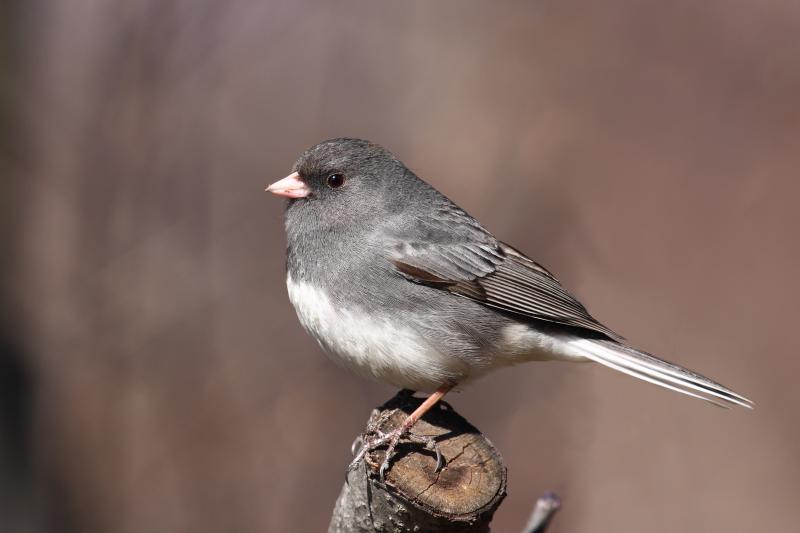A Snowbird Surprise
Called the “snowbird” by many people, the species officially known as the dark-eyed junco is a common and widespread winter visitor to much of the U.S. Here in Maine, flocks of juncos from Canada’s Boreal Forest descend into our state each fall. Some stay the winter, but most continue farther south where there is less snow cover and more opportunities for these little, ground-feeding birds to find small seeds. In spring, the flocks return north and numbers surge here again in March and April.
Dark-eyed juncos breed right here in Maine as well, but they are less conspicuous during the summer nesting season, and they tend to occur in places with spruce, fir, and hemlock. They usually disappear from our neighborhood by late April although if we searched, we could probably find some nesting within a few miles away in summer.
Now, in early April, we are still enjoying the dark-eyed juncos that are hanging around our backyard feeding station. We especially delight in hearing them softly singing on warm days. The song of the junco is a rather simple trill—a rapidly repeated series of short notes on the same pitch. It is one of a group of birds with trilling songs that can be quite difficult to tell from one another. Chipping sparrows, pine warblers, and swamp sparrows are among the infamous trillers whose songs have confused many a birder.
All of these tidbits are factoids we knew about dark-eyed juncos. But yesterday, while sitting on the porch in the sun, sheltered from the cold wind that tossed the tree tops and spun last year’s brown leaves into the sky, we listened closely to a junco softly singing from the lilac on the other side of the driveway. It was doing something different. Rather than a single long trill, it was giving short pulses of trills interspersed with other sounds. As we listened more closely we realized that at least some of those interspersed sounds were imitations of the calls of other birds. They were short calls and some were not completely obvious but we clearly heard imitations of the squeal call of the American robin and the call note of the house finch.
We were astounded!
Unfortunately, the bird stopped singing soon after this so we didn’t get to discover what other bird imitations it had added into its repertoire. We had to find out if this was just a singular oddity of this particular bird on this particular day so, of course, we turned to Cornell’s the online “Birds of the World” and called up the species account for dark-eyed junco. This exhaustive reference contains just about everything anyone would want to know about many of the birds of the world (at least for North American birds). Sure enough, in reading the species account, we discovered that juncos have two regular song types. One is the familiar long trill (called the Long Range Song), but there is another song type, called, perhaps not surprising, the Short Range Song. That song is the one that we had heard.
And the surprises continued. Juncos had been documented incorporating the calls of American goldfinch, pine siskin, and red crossbill into their Short Range Songs. Individuals had also included imitations of songs of other birds into their Long Range Songs, including white-crowned sparrow, spotted towhee, brown creeper, and American redstart.
Why they do these imitations is not an easy question to answer, and we haven’t really seen any speculation specific to this species and this behavior. In some species, having a large song repertoire seems to be a way for males to show to perspective mates that they are clever and skilled, so would make a good mate, and to tell rival males that they better stay away. But these quiet songs, given in migration or on the wintering grounds, wouldn’t seem to be done for the same reason.
So it remains a wonderful mystery, and one that we listen for and hope we may savor at least once more before the juncos, the “snowbirds,” leave our neighborhood for the summer.
Jeffrey V. Wells, Ph.D., is a Fellow of the Cornell Lab of Ornithology and Vice President of Boreal Conservation for National Audubon. Dr. Wells is one of the nation's leading bird experts and conservation biologists. He is a coauthor of the seminal “Birds of Maine” book and author of the “Birder’s Conservation Handbook.” His grandfather, the late John Chase, was a columnist for the Boothbay Register for many years. Allison Childs Wells, formerly of the Cornell Lab of Ornithology, is a senior director at the Natural Resources Council of Maine, a nonprofit membership organization working statewide to protect the nature of Maine. Both are widely published natural history writers and are the authors of the popular books, “Maine’s Favorite Birds” (Tilbury House) and “Birds of Aruba, Bonaire, and Curaçao: A Site and Field Guide,” (Cornell University Press).
























